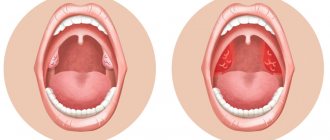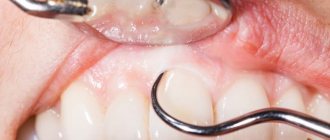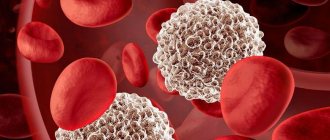1.General information
Laryngospasm (spasm of the larynx) is an involuntary and uncontrolled contraction of the muscles of the larynx, during which the glottis closes, the flow of air into the airways is blocked and a state of inspiratory asphyxia occurs (inability to inhale).
Prolonged asphyxia can lead to general oxygen starvation of tissues and death.
Due to the age-related characteristics of the structure and functioning of the ENT organs, laryngospasm is most often observed in children in the first months and years of life, but it also occurs in adults.
A must read! Help with treatment and hospitalization!
Signs
Acute laryngotracheitis in children and adults is manifested by the following symptoms:
- symptoms of general intoxication are clearly expressed;
- the throat is sore, which provokes a cough;
- barking cough (especially pronounced in a child);
- sore throat;
- voice changes. He becomes rough and hoarse. In more severe cases, aphonia is observed;
- respiratory dysfunction. A child or adult experiences wheezing, noise, and shortness of breath;
- increase in body temperature. Usually the readings do not exceed 38 degrees, but there are times when the temperature can rise to high numbers.
2. Reasons
Laryngospasm is a neuromuscular reflex that can be caused by many factors.
The main groups of such reasons include:
- inflammation in the respiratory system (pneumonia, bronchitis, tracheitis, laryngitis, etc.);
- neurodegenerative diseases (especially those affecting the spinal cord);
- infections and tumors of the central nervous system;
- severe generalized infections (eg, tetanus);
- irritation of the larynx with chemicals, allergens, medications, very cold or hot air;
- deficiency of vitamins and/or microelements;
- vascular pathology (severe hypertension, aortic aneurysm, etc.);
- neuropsychic factors (psychotrauma, hysterical attack, nervous overstrain, severe crying in children, fear or laughter);
- foreign bodies or tumors in the upper respiratory tract.
Visit our Otolaryngology (ENT) page
Causes of acute laryngotracheitis
There are many reasons and prerequisites for the occurrence of acute laryngotracheitis. Almost always it is of an infectious, viral or bacterial nature.
Acute laryngotracheitis is observed in the following diseases:
- Parainfluenza;
- Flu;
- Adenoviral infection;
- ARVI and acute respiratory infections;
- Chlamydial infection;
- Staphylococcal infection;
- Chickenpox;
- Scarlet fever;
- Measles;
- Rubella;
- Syphilis;
- Mycoplasmosis;
- Streptococcal infection;
- Tuberculosis of the larynx;
- Pneumococcal infection.
Laryngotracheitis occurs with the above types of diseases in case of weakened immunity in general. Sometimes only the larynx or only the trachea may be affected. There are cases of acute laryngotracheitis for other reasons. Thus, the prerequisites for the disease may be allergic reactions of the body or the aggressiveness of chemicals. Herpes lesions of the respiratory system occur, causing acute laryngotracheitis.
3. Symptoms and diagnosis
Against the background of the above conditions, diseases and influences, laryngospasm often develops suddenly. However, in some cases it is preceded by such warning signs as shortness of breath, hoarseness or decreased voice volume (up to complete aphonia), and a “barking” cough with laryngitis. The classic clinical picture of laryngospasm includes changes in complexion, noisy shallow breathing, and panic (which in this condition can rapidly develop not only in a child, but also in an adult). The head is usually thrown back, and with severe hypoxia, cyanosis is observed. Choking, the patient may lose consciousness; in severe cases, cardiac arrest occurs. Sometimes laryngospasm is accompanied by an epileptiform seizure, including involuntary relaxation of the sphincters.
The duration of laryngospasm ranges from a few seconds to several tens of seconds. With hysteria, the attack passes spontaneously and does not require outside help (most often it is enough to eliminate the psychogenic situation or simply deprive the patient of the audience, i.e. leave the room).
If there is a predisposition to laryngospasms, they may occur repeatedly during the day. There is a tendency towards seasonality: laryngeal spasms are more often observed in the cold season.
The diagnosis is established clinically and anamnestiically. During laryngoscopy, a tight closure of the vocal cords and arytenoid cartilages is observed.
About our clinic Chistye Prudy metro station Medintercom page!
Symptoms of acute laryngotracheitis
Acute laryngotracheitis is characterized by a rapid increase in symptoms. The severity of symptoms depends on the degree of damage to the tissues of the larynx and trachea.
- Infiltrative-purulent or phlegmonous laryngotracheitis, which is characterized by damage to the underlying layers of the mucosa, muscles, cartilage, is characterized by a rise in temperature to 38C - 39C.
- Catarrhal laryngotracheitis, which is characterized by damage to the internal mucous membrane and the release of mucous discharge, is characterized by a satisfactory condition of the patient, normal or slightly elevated temperature.
Acute laryngotracheitis is accompanied by severe pain in the throat and difficulty when trying to take a sip of liquid. The patient loses his appetite, he experiences increased symptoms of intoxication, and his overall condition worsens significantly.
Also characteristic symptoms of laryngotracheitis are changes in voice. It becomes hoarse, rough, and loses sonority. Laryngotracheitis is accompanied by a dry, barking cough, more often in the morning and at night. After a coughing attack, the patient feels pain in the chest. A cough can be triggered by taking a deep breath, laughing, or inhaling cold, polluted air. At first, the cough is dry, without phlegm. As the disease progresses, the cough is softened by the appearance of sputum. Over time, the sputum becomes mucopurulent and profuse. At the same time, pain, sore throat, and constant discomfort when swallowing are noted. Painful sensations occur when trying to talk, while exhaling, while inhaling. All changes are accompanied by a deterioration in general well-being.
A serious danger with laryngotracheitis is laryngeal stenosis. With this phenomenon, the access of air to the lungs is completely or largely stopped as a result of severe narrowing of the larynx.
4.Treatment
First aid includes providing a supply of fresh, preferably moist, air. It is extremely important to calm the patient and stop panic, but if laryngospasm occurs in a child, this is extremely difficult to do in practice. In some cases, locally distracting pinching, patting, artificially inducing vomiting, or sprinkling the face with drops of water help. It should be remembered that prolonged asphyxia can be fatal; Thus, laryngospasm is an emergency condition and requires an immediate call to the ambulance. In the most severe cases, the patient is intubated or an emergency tracheostomy is performed, but it is obvious that these operations can only be performed by a doctor.
Treatment strategy and tactics are determined by the results of a mandatory diagnostic examination. In particular, the primary measure may be to eliminate hypovitaminosis and micronutrient deficiency. In other cases, neurological or psychotherapeutic treatment is necessary. Physiotherapeutic procedures, restorative measures, and sanatorium-resort treatment play an important role.
It is noted that the tendency to laryngospasm in children usually decreases spontaneously during puberty and adulthood.
Symptoms of chronic laryngotracheitis
Particular attention should be paid to cough. If in the acute form of laryngotracheitis it is episodic and paroxysmal, then in the chronic form of this pathology the cough is permanent. Moreover, the patient constantly experiences a feeling of discomfort in the pharynx and trachea, as well as frequent painful sensations behind the sternum. A constant persistent feeling that the throat is scratched, dry mouth, painful swallowing - this is an incomplete list of manifestations of chronic laryngotracheitis.
The most characteristic diagnostic sign is dysphonia or disturbances in the patient's voice function. Dysphonia can vary in intensity from mild “hoarseness” to complete inability to speak. Attempts to make sounds cause discomfort to the patient. This condition can be aggravated by certain climatic factors or various hormonal changes. Particularly severe forms of dysphonia occur in women during menopause, during pregnancy or during menstruation. This condition can be either periodic or permanent.
Persistent dysphonia indicates various morphological changes in the structures of the vocal cords. If the patient’s professional activity involves the need to constantly communicate and be in public, the slightest changes in voice timbre can become a psychologically traumatic factor for them. As a result of this, the patient’s psychosomatic state is disrupted: sleep dysfunction, constant nervous tension, depression or neurasthenia.
Stages and degrees
Laryngospasm in adults (symptoms and treatment depend on the stage of the disease) is divided into 4 types based on severity:
- First. There are no clinical symptoms; only a slight narrowing of the lumen of the larynx is diagnosed. The patient experiences a slight malaise, which he perceives as a minor health disorder and does not associate it with spasms. The first degree of laryngospasm is not dangerous, but may begin to progress. Therefore, regular monitoring of the patient's condition is required.
- Second. Symptoms slightly intensify, and the patient experiences mild respiratory failure. Respiratory distress and blue discoloration of the nasolabial triangle may occur. Symptoms worsen with vigorous physical activity. The skin turns pale and becomes waxy. But the second degree of laryngospasm responds well to treatment, the person recovers quickly. If there is no treatment, the disease becomes unpredictable and abruptly progresses to the next stage.
- Third. All the symptoms of laryngitis appear, the lumen narrows greatly, and more than 50 percent is blocked. Severe respiratory failure occurs. The pathological process does not go away on its own; it gradually intensifies. Additionally, drowsiness, weakness and bluish skin are noted. There is a real threat to life. This condition requires emergency medical care and rapid correction. The patient's condition is aggravated by a severe panic attack. The patient experiences unaccountable fear, agitation, and anxiety. Excessive disorderly fussiness.
- Fourth. This is the most severe degree of laryngospasm, which is characterized by critical respiratory distress and serious cardiac dysfunction. If medical assistance is not provided immediately, the person dies within a few minutes.
Depending on the form of manifestation, laryngospasm can occur in mild or severe form. In the first case, doctors quickly eliminate the symptoms, restore breathing and oxygen supply. In severe cases, it is difficult to relieve the attack; often doctors do not have time to help, and death occurs.
Complications
Significant swelling and accumulation of sputum in the lumen of the larynx during acute laryngotracheitis can become a reason for the development of such a serious complication as stenosing laryngotracheitis, or false croup.
Chronic laryngotracheitis under certain circumstances can give rise to the development of tracheitis, bronchitis, bronchiolitis and pneumonia. In addition, constant irritation of the mucous membrane of the larynx and trachea can contribute to the appearance of a benign or malignant tumor. Complications of hypertrophic laryngotracheitis may include the appearance of laryngeal ventricular prolapse or laryngeal ulcers, and the formation of cysts.
Treatment methods
Laryngospasm in adults (symptoms and treatment depend on diagnostic results) often causes panic. To prevent it, the patient needs to be given water, moisten his face with it, and provide access to fresh air. Light pinching and patting on the cheeks will be effective. You can give ammonia to smell.
A mild attack will go away on its own within a minute; in a severe case, you need to urgently call an ambulance. The main treatment for laryngospasm is medication. It is aimed not only at eliminating symptoms, but primarily at eliminating the root cause of attacks.
| Group of drugs | Brief description, dosage |
| Antispasmodics |
|
| Antihistamines | These drugs are prescribed if the spasms were caused by allergic reactions. “Suprastin”, “Tavegil” are taken 1-2 tablets a day or given intramuscular injections. |
| Bronchodilators | They relax smooth muscles, eliminate spasms, and expand the lumen of the bronchi. "Fenoteir" and "Salbutamol" are produced in an aerosol. The drug is injected at intervals of 3 hours, up to 4 times a day. "Teofedrin-N" is produced in tablets. The drug relieves spasms and calms the nervous system. Take ½ tablet once, after meals. |
| Hormonal | Hormonal drugs are used once - only to relieve an attack. For example, Dexamethasone is injected intramuscularly for swelling of the throat and difficulty breathing. The drug acts quickly, but hormonal drugs are used with caution. They have strong side effects and can be harmful if used frequently. |
| NSAIDs | These drugs are prescribed if inflammatory processes are the cause of lyringospasms. For example, “Nise” is taken 1-2 tablets per day. Stop taking as soon as the medicine relieves symptoms. NSAIDs also act as a pain reliever. |
| Antibiotics | Antibiotics are prescribed if the cause of laryngospasm is an infectious disease. Several groups of these drugs are produced. The choice of medication depends on the infectious agent, but more often a broad-spectrum drug is prescribed. The course of treatment is 5-7 days, maximum 14 days. |
| Sedatives | Prescribed if attacks are caused by stress or emotional overexcitation. The safest are “Motherwort” and “valerian infusion”. Pour 40 drops into a small amount of water and drink 2-3 times a day. But these drugs need to be taken for a long time, so sedatives are more often prescribed for the chronic form of the disease. |
| Homeopathic | They help prevent convulsive compression of the glottis:
|
The cause of laryngospasm may be vitamin deficiency. Then the basis of treatment includes vitamin complexes.
Surgical operations
Laryngospasm in adults (symptoms and treatment may indicate the need for surgery) is sometimes treated only with surgery. It is indicated for cases of high risk of suffocation.
Can also be done:
- tepeotomy – dissection of the thyroid cartilage;
- tracheotomy – elimination of spasm, restoration of breathing;
- conicotomy – surgery in the area of the conical fold;
- cricotomy – the arch near the cricoid cartilage is removed;
- dissection of the trachea - removal of foreign bodies, ensuring access to oxygen.
When the larynx is completely blocked, tracheal intubation is performed. A tube is inserted into the throat, through which oxygen enters and the patient can breathe.
Physiotherapy methods
Physiotherapy methods are used as an auxiliary treatment. They help reduce the frequency of attacks and improve general condition. If the cause of spasms is damage to the bronchi, then massage and physical therapy will be effective. Electrophoresis and inhalation procedures based on herbal preparations are also prescribed.
For laryngospasms, acupuncture (acupuncture) helps well. The needles are inserted into specific points on the body. This helps even with chronic and advanced forms of the disease. Using the procedure, protective functions are activated. As a result, the body will begin to recover on its own. Acupuncture calms the nervous system, relieves pain and inflammation, and improves metabolic processes.
Traditional methods
There are several methods that are used to relieve a mild attack. You need to hold your breath for 5 seconds, then slowly exhale through pursed lips. Repeat until the attack passes. During an attack, put a straw in your mouth and suck in air through it. This helps relax the ligaments and stimulates slow breathing.
Folk remedies:
- To dilate the bronchi 2 tbsp. l. baking soda pour 1-2 liters of boiling water. After the crystals have dissolved, the product is used for steam inhalation. The duration of each procedure is 5 minutes.
- To reduce spasms and restore the nervous system, prepare tea with chamomile, lemon balm, valerian and mint. The components are taken in equal proportions. Then 1-2 tbsp. l. the mixture is poured with a glass of boiling water. Leave for 20 minutes, filter. If the tea is too concentrated, it can be diluted with water.
- Add 1 tsp to a glass of milk. honey, a pinch of nutmeg, cloves and cinnamon. Then the mixture is heated and drunk warm. Milk with spices and honey will soften the respiratory tract.
- Rub 200 g of rowan berries through a sieve. Add 100 g of granulated sugar to the mixture and stir until it is completely dissolved. Transfer the product into a glass container. Keep tightly closed. Take 1 tsp daily, on an empty stomach.
- Hawthorn, oregano, and beech are mixed in equal parts. Coltsfoot, meadow clover and veronica officinalis are added to them in the same proportions. Take 1 tbsp. l. mixture of herbs, pour 300 ml of boiling water, leave for 10 hours, filter and drink warm, half a glass, 5-6 times a day.
- Mix 1 tbsp. l. crushed ginger root, rosemary, meadow geranium. Thyme, maryannik, and mint are added to them in the same quantity. Transfer the herb mixture into a glass jar and pour in 1 liter of warm red wine. Add ½ tsp. ground red pepper. The drink is infused for two days, filtered and drunk before bed, 50 ml each.
You can use the impact on a special point. With laryngospasm, it is located just above the jaw, behind the earlobe. You need to press firmly on the point - down towards the throat. If performed correctly, pain appears and the spasm goes away. Warm baths with potassium bromide solution may also help. Laryngospasm is relieved by touching the root of the tongue with a spoon.
Kinds
Laryngospasm is a sudden attack of narrowing of the lumen of the larynx, with a high risk of mortality. The disease can be primary or secondary; it is caused by other pathologies and inflammations.
There are three types of laryngospasm:
- Infectious. It occurs rarely. The infection itself does not provoke the disorder, but creates favorable conditions for the development of the pathological process.
- Allergic. It can be primary if it develops spontaneously, without signs of preliminary damage. Or secondary, when the spasm is caused by injury or infection. Both varieties are very dangerous.
- Mixed. It combines the first two varieties. The mixed appearance is difficult to correct, especially in the chronic form due to the infectious process.
Laryngospasm in adults
After 18 years, the likelihood of attacks is significantly reduced due to the completion of the formation of the respiratory tract and larynx.
Prevention
Prevention of laryngotracheitis consists of a set of measures:
- breathing exercises;
- hardening from an early age;
- diet excluding spicy, salty, sour, hot or cold foods;
- sports are required;
- prevention of ARVI;
- prevention of inflammatory processes in the larynx;
- prevent hypothermia of the body;
- taking immunomodulatory drugs.
If laryngotracheitis proceeds normally, without complications, then recovery occurs within a week. You should not self-medicate; the treatment process should be under the supervision of the attending physician.
How to treat laryngotracheitis?
Typically, inflammation of the upper respiratory tract does not require hospitalization of an adult patient (except in cases of stenosing laryngotracheitis), so treatment at home is more often used:
- Eliminate all harmful factors that provoke the development of laryngotracheitis (prohibit smoking, talking, drinking and eating hot, spicy, sour foods);
- The patient is given a warm room with humidified air, given a lot of warm (but not hot and irritating) drinks (jelly, teas, compotes);
- If the temperature crosses the border of low-grade fever (38°C), reduce it with paracetamol, ibuprofen or other antipyretics available in the house;
- They do alkaline inhalations at home, and when the temperature drops or during a chronic course of the disease, they invite the patient to visit the physiotherapy room of the clinic (inhalations, electrophoresis, UHF, etc.)
- They give expectorants and antitussives, use antihistamines;
- The patient should not rush to prescribe antibiotics at his own discretion, just like his parents, if it concerns a child. Laryngotracheitis, which is of viral origin, still does not respond to them, so the body does not need these drugs. In general, antibacterial and antiviral treatment at home is carried out under the supervision of a doctor.
In case of chronic hypertrophic laryngotracheitis, in cases where there is no effect from conservative therapy or there is a threat of transformation into a neoplastic process, surgical intervention is resorted to. Excision of overgrown tissue, elimination of ventricular prolapse, and removal of cysts are performed using endoscopic microsurgical technologies.
Throat neurosis, dysphagia (spasms, VSD)
Anastasia, Moscow
May 26, 2020
Good afternoon, dear specialists! I will briefly describe my problem: over the course of 4 years, due to stress and family disasters, all the symptoms of VSD and laryngeal neurosis appeared in all their glory (I know that it is not a disease, but a number of neurological disorders). Now the slightest stress, tears or anxiety with worry: immediately there is nervous dysphagia! It has reached such a point: I can’t eat or drink for periods; I have a strong spasm in my throat and I CAN’T SWALLOW anything. I’m exhausted, I can endure anything! But here there is a complete shutdown of the swallowing function, a spasm of the throat (a choking sensation and the throat is all constrained with the nasopharynx) and after a while saliva is swallowed with difficulty, then saliva disappears, insomnia torments, cramps and numbness in the arms and legs, face, tremors. Coldness of the extremities and numbness (everything inside has been examined - there are no pathologies, only gastritis, esophagitis and reflux, a lump in the throat is bothering me. The thyroid gland is also normal, all hormones are normal (nodules now and no pathologies there) except androgens - dihydrotestosterone: increased, struggle with I've been around for a long time) I have to control the swallowing process, it gets to the point of fright and it becomes even worse. There is osteochondrosis of the cervical spine (and this is asthenic weakness, almost constant headaches and severe pain in the back of the head, difficulty breathing and low blood pressure: 90/60, rarely rises higher than that). Plus, 7 years of sinus tachycardia (when walking and after eating, the pulse can be 120-150 at once, and out of the blue, ultrasound of the heart was done more than once and recently a Holter was installed, a small number of systoles: mitral valve prolapse of 1-2 degrees, periods of extrasystole). How can you combat such disorders, in particular swallowing problems. Thank you very much! (There were 2 thrombosis of the legs of the lower extremities after injuries). AND THE MOST IMPORTANT THING: WHAT TO REMOVE STRONG LARRYNAL SPASMS so that the water doesn’t get stuck (this week I was in an ambulance 3 times and couldn’t relieve the spasms). The next appointment at the neurosis clinic is in a week or two. I would be very glad for any tip or specialist (because this is already a complete nightmare). Abdominal ultrasound done, MRI 3 years ago: nothing to complain about, 3 years in a row: gastroscopy, superficial gastritis, and in 2021 they diagnosed cardiac insufficiency of the esophagus, they said it’s no big deal). In turn, I will list the main drugs that were prescribed by specialists: Cipralex was in 2016 for 7 months (nothing else from the blood pressure is suitable, the last one was prescribed 2 weeks ago amitriptyline: it was wildly bad and I tried to take it for a week, I just lay there and didn’t eat) , from tranquilizers: phenazepam and clonazepam are known to everyone (I took a clone for almost 1.5 years, 1/4 or 0.5, rarely of Polish origin), our Russia does not help, (now there was a break of 7 months in taking it), then we tried: phenibut, Atarax, Stresam, Grandaxin, Trittico, Velaxin, Fevarin, Taraligen, Prosulpin, Alprozalam (I took it for 3 weeks: there was a zombie effect, it did not help with dysphagia). I understand that the issue is complex and, unfortunately, I can’t overcome the problem. Thanks a lot!
The question is closed
tremor
Dysphagia
throat neurosis
the spasm is strong






